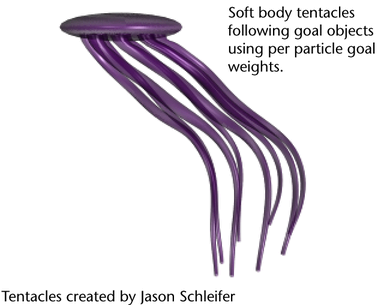A goal is an object that particles follow or move towards. You can use goals to give trailing particles a flowing motion that’s hard to generate with other animation techniques. The trailing particles move as if connected to the goal by invisible springs. In the context of goals, soft bodies are considered particles.

A goal can be any object except a curve on surface. The movement or motion of the trailing object depends on the type of goal object and the number of goal objects connected to the trailing object.
About nParticle goals
Particle objects are useful as goal objects because of the many techniques available for animating particle motion. You can't add a goal to individual particles of the particle object, but you can control how influential each particle is on the trailing object.
If the goal is a particle object, its particles attract the particles of the trailing object one for one as the animation plays. If particles in the objects do not die, the trailing particles follow goal particles based on the creation order. For example, the particle created first in the trailing object follows the particle created first in the goal object. The particle created last in the trailing object follows the particle created last in the goal object.
If particles in either object die, the preceding scheme no longer applies. You can no longer visually predict which trailing particle will follow a particular goal particle.
If the trailing particle object has more particles than the goal object and particles don't die in either object, the extra particles follow the first-created particles of the goal.
Nonparticle goals
If the goal is a NURBS object, polygonal object, or lattice, its CVs, vertices, or lattice points attract the particles one for one. Extra particles follow the points in the goal object by starting over at the beginning points. The method is the same as described for particle objects.
If the goal is an object other than a lattice, NURBS, or polygonal object, for example, a light or camera, the object's transform becomes the goal.
Multiple goals
You can use more than one goal object to affect a particle object. For each goal object, the trailing particle object has a goal weight that sets the relative weighting of the attraction. If the goal weights are the same, each goal object attracts the trailing object with equal strength. The trailing object moves to a position between the two goal objects, typically oscillating back and forth before coming to equilibrium.
If the goal weights differ, each goal object attracts the trailing object with different strength. The trailing object comes to rest at a position closer to the goal with the higher goal weight.